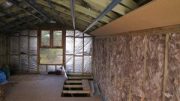A home that will keep you warm and cool the planet
“… everything from mining the materials for the cement to chopping down the trees for the floorboards to transporting everything to the building site to digging the foundations; and then later from knocking the building down to disposing of its constituent parts.”
If climate change makes you want to want to stay in bed all day and forget the world outside then I have some bad news. About 28% of global CO₂ emissions can be traced to the energy generated to light, cool and heat buildings, while a fifth of the UK’s emissions come from heating and powering homes. So a good chunk of your carbon footprint can be laid down before you’ve even left the house.
And that’s just the emissions that governments tend to count. Much of housing’s greenhouse gases come at other stages in a home’s life, including construction and demolition. These are called “embodied emissions”, and can make up as much as 90% of the whole-life emissions of some buildings.
“What I mean here is the carbon emissions involved in making, renovating and then eventually dismantling the building,” says Francesco Pomponi, vice chancellor’s research fellow at Edinburgh Napier University […].
There are likely to be an extra 2 billion people on Earth by 2050, with most being born throughout Asia and Africa. Developing countries will need hundreds of millions of additional homes over the coming decades, while global emissions will need to fall by 60% to keep average warming below 2°C.
[…]
First, let’s ditch concrete
Concrete is a wonder material, but like most of the innovations behind modern life’s conveniences, it’s carbon intensive. Fired bricks need temperatures higher than 1,000°C to cause chemical changes that give the material strength, and it’s as high as 1,450°C for cement. Just producing cement is thought to account for between 5-10% of global greenhouse gas emissions.
Since most new homes will be built in the developing world, experts agree that a greener concrete substitute will have to be affordable, attractive and made from locally sourced ingredients. But perhaps “green” isn’t the right word. Alastair Marsh, a research fellow in civil engineering, and Venkatarama Reddy, a professor of civil engineering, believe that soil could be the perfect component for geopolymers – a naturally strong and durable alternative to cement.
- How it works – Soil is taken from beneath the valuable surface layer and mixed with chemicals similar to those found in household cleaning products to dissolve the clay minerals into their constituent atoms. A playdough-like mix is formed that can be shaped in brick moulds. During firing at 80-100°C, the dissolved atoms rearrange to form a geopolymer, stabilising the remaining soil.
At a glance: transformation of clay (left), a common component of soil, into a geopolymer (right). A geopolymer is a hard and durable substance similar to cement
- Brown is green – Soil-based geopolymers can be fired at lower temperatures and their ingredients don’t need to be shipped long distances. Depending on the conditions, these bricks could have half the carbon emissions of concrete, and a quarter of the amount produced by conventional fired bricks.
- Back to basics – Earth-based housing has been the norm in many parts of the world for thousands of years, so there is a rich cultural history behind this idea in most places.
“The stakes are high – housing supply and climate change are two of the biggest issues of our time. These more sustainable bricks may well be a piece of the puzzle.”
Alastair Marsh
Postgraduate Researcher, Department of Architecture & Civil Engineering, University of Bath
Venkatarama Reddy
Professor of Civil Engineering, Indian Institute of Science
Then let’s talk about heating
Bricks and mortar are just the start. Heating and energy use is the long-term source of carbon emissions in housing – it accounts for 18% of the UK’s total emissions. Even homes made with sustainable materials will leak heat and guzzle electricity if poorly designed.
Stephen Berry, whose research focuses on the relationship between people, buildings and technology, argues that our ancestors knew how to design homes that could regulate temperature without energy and regardless of the climate.
By implementing design features that capture cool air and keep rooms aerated, Iranian architects were leading the world in zero-carbon home design – more than a thousand years before people started thinking about the emissions from their home energy use.
At a glance: some 2,300 years before the first electric refrigerator, Persians engineered cold storage units that made ice available year-round even through scorching desert summers
Modern experts in low carbon architecture have developed a standard that strives to ensure all new homes produce as much energy as they consume. There are 400,000 of these “Passivhaus” certified buildings across Europe, and according to Jo Richardson, a professor of housing and social inclusion, and David Coley, a professor of low carbon design, living in a zero-energy home is almost like buying a car that comes with free petrol for life.
At a glance: a Passivhaus home (right) leaks less heat than a traditional building (left)

Source: Passivhaus Institut/Wikipedia, CC BY-SA
So how come Passivhaus homes have heating bills that are a tenth the UK average?
- Airtight and toasty – Passivhaus homes have much thicker insulation than other houses, with triple glazed windows to trap warm air and mechanical ventilation that can recover and circulate waste heat.
- Self-powered – By installing solar panels on the roof, Passivhaus homes can produce some of the energy they use.
- Rigorous and reliable – The Passivhaus scheme requires energy modelling to determine if a home will truly produce as much energy as it consumes. A guarantee that the correct insulation and other features have been delivered and fitted must also be rigorously reported to a third party.
“Most people would pay more for a car that came with free petrol for life, which is close to what a zero-energy home is … Residents of a three-bedroom semi-detached house could expect heating bills of around £50 per annum.”
Jo Richardson
Professor of Housing and Social Inclusion, De Montfort University
David Coley
Professor of Low Carbon Design, University of Bath
🌍 Low-carbon ‘warm homes for all’ could revolutionise social housing
Decarbonisation starts at home
Retrofit your home
If you’re living in a damp and drafty home that was built long before you were born, you might envy anyone living in a zero-energy new build. While you pay much higher heating bills, a lot of that precious warmth could be lost through poorly insulated walls and windows.
Jo Richardson describes how retrofitting existing homes with insulated walls and windows could help make homes more energy efficient and drive down heating bills.

Rethink your gas system
But if a house is still reliant on burning natural gas to heat a water boiler, the source of carbon emissions remains. There are more than 23 million homes with a gas supply for heating and cooking in the UK – an energy burden that amounts to more than double the country’s annual electricity consumption and produces about 60 million tonnes of CO₂ emissions each year.
One way to decarbonise gas heating is to swap the fuel for something zero-carbon, like hydrogen gas. Another is to switch gas-fired boilers and ovens with electrical appliances.
Seamus Garvey, a professor of dynamics, says that replacing boilers with electric heat pumps would be most energy-efficient. Electricity can be converted directly to heat with 100% efficiency using cheap resistive elements – the same parts that are present in fan heaters and oil-filled radiators.
Heat pumps use electricity to extract the input heat from a nearby river or stream, from the ground or from the air itself. This is known as the “cold source”. The process of extracting heat works similarly to how refrigerators remove heat from food. According to Garvey, delivering a convenient cold source to homes with heat pumps could provide old gas heating networks with an unlikely zero-carbon future.
Recycling rainwater to help run electric heating is one (particularly creative) way of decarbonising energy use in homes, but it doesn’t count for much if the electricity came from burning fossil fuels.
Produce your own renewable energy
Over the last two decades, electricity grids have changed to accommodate “prosumers” – homes that produce and consume their own renewable electricity, often using rooftop solar panels or other sources of “microgeneration”, like small wind turbines.
Energy cooperatives have formed between neighbours, where homes can generate, store, and trade energy with each other. “One house can buy excess renewable generation from a neighbour’s solar panels, or from a community wind turbine,” say a group of energy researchers at Heriot-Watt University.
Own energy production (with your community)
Community ownership of energy production has proven a successful model for increasing renewable generation, according to Iain MacGill and Franziska Mey, energy experts at the University of New South Wales and the University of Technology Sydney.
Germany reached 32% renewable electricity in 2015 with a target of 40% to 45% by 2025, and has some 850 energy cooperatives. Almost half of its installed capacity is owned by households, communities and farmers.
Denying the state a monopoly on renewable energy could win supporters that are usually sceptical of government efforts to limit climate change.
Research by Sarah Mills, a project manager for the National Surveys on Energy and Environment in the US, found that states of Iowa, Kansas and Oklahoma – all of which voted for Donald Trump in 2016 – lead the country in renewable energy generation, with more than 30% of the power generated in each of these states coming from wind turbines and other renewable sources. Three nearby Great Plains states, Nebraska, South Dakota and North Dakota – all solid Republican – are also in the top ten.
At a glance: many communities in conservative states see renewable energy as an economic opportunity … They like wind and solar power. They just don’t want the government to tell them that they must use renewable energy

In time, you could become part of the ‘civic’ energy sector
Individual households generating energy and distributing it among communities with support from local authorities – this “civic” energy sector could become a dominant model for energy generation in the future according to Stephen Hall, a research fellow in energy economics and policy. It’s what energy systems might look like if “the move to a low-carbon society [isn’t] left to governments and big energy companies”, Hall says, and letting homes lead the way could have major benefits.
- Smarter energy grid – Fewer big power plants would be needed if electricity generation came from multiple sources, disrupting centralised monopolies.
- Pay when you use, not how much – Energy utilities currently set consumers’ tariffs according to the volume of energy they use. This system means it’s not in the interest of the energy producer to help people reduce their demand or become more energy efficient. A smarter, decentralised system could instead charge customers according to when they use energy.
- Think local – Local authority energy companies could charge residents for services such as “having a warm home” or “hot water”. This would encourage authorities to keep homes warm and well lit as cheaply as possible – promoting energy efficiency.

“Civic energy would need some early support, but it could soon become the natural preference over what an increasingly outdated utilities sector is offering.”
Stephen Hall
Research Fellow in energy economics and policy, University of Leeds
🌍 No more big power plants? Civic energy could provide half our electricity by 2050
Overhaul housing entirely
Regardless of collective ambition on climate change, housing will have to change drastically in many places in the years ahead to help people resist the world outside. Homes – places of refuge and safety – could become the very opposite as old certainties suddenly disappear.
In the UK, 1.8 million people currently live in areas that are at significant risk of flooding – and their flood risk is likely to increase as the climate warms. According to Hannah Cloke, a professor of hydrology, we may need to consider radical practices such as houses that are designed to float when floods come, mechanically sealable flood doors, waterproof floors …
If housing policy has nurtured high-energy lifestyles, by encouraging people to live in dense suburbs with at least one car on the drive, Richard Kingston and Ransford Acheampong, experts in urban planning, believe it can be re-engineered to encourage ways of living that are healthier for people and the planet.
“We need to build high density, mixed-use developments with affordable housing and excellent green spaces … provide basic services within walking distance, create safe spaces for people to walk and provide public transit that uses clean energy.”
Richard Kingston
Professor of Urban Planning and GISc, University of Manchester
Ransford A. Acheampong
Presidential Academic Fellow in Future Cities, University of Manchester
🌍 Climate change: we can reclaim cities from the car without inconveniencing people
More from The Conversation
🌍 Beyond Bitcoin: how blockchains can empower communities to control their own energy supply
🌍 Making homes better for the climate, your wallet and health
🌍 Homes are changing too slowly – but you can make your house a superhome
🌍 People who can’t heat their homes need energy justice – not ‘fuel bank’ charity
Originally published by The Conversation.






